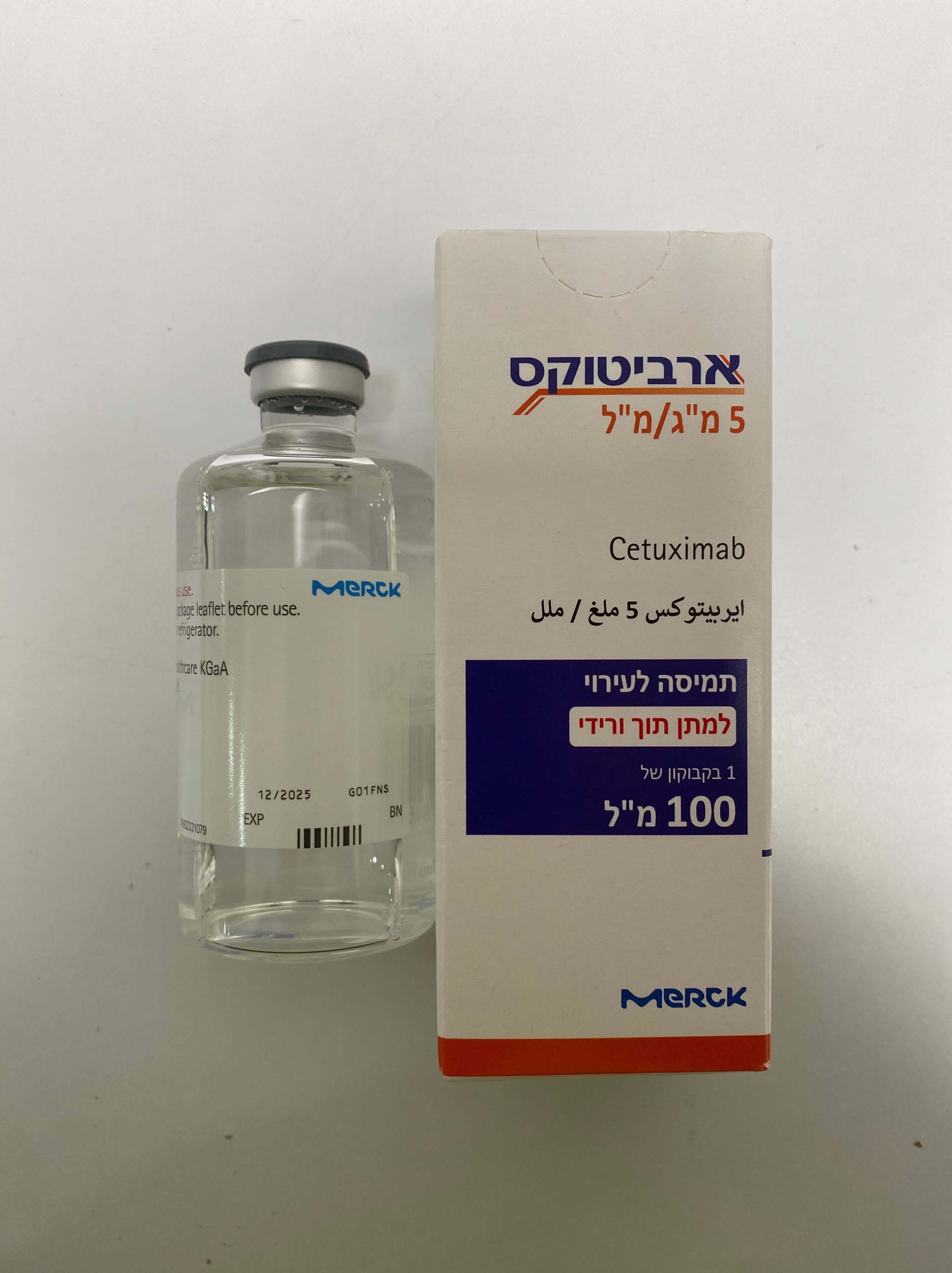Quest for the right Drug

ארביטוקס 5 מ"ג/מ"ל ERBITUX 5 MG/ML (CETUXIMAB)
תרופה במרשם
תרופה בסל
נרקוטיקה
ציטוטוקסיקה
צורת מתן:
תוך-ורידי : I.V
צורת מינון:
תמיסה לאינפוזיה : SOLUTION FOR INFUSION
עלון לרופא
מינוניםPosology התוויות
Indications תופעות לוואי
Adverse reactions התוויות נגד
Contraindications אינטראקציות
Interactions מינון יתר
Overdose הריון/הנקה
Pregnancy & Lactation אוכלוסיות מיוחדות
Special populations תכונות פרמקולוגיות
Pharmacological properties מידע רוקחי
Pharmaceutical particulars אזהרת שימוש
Special Warning עלון לרופא
Physicians Leaflet
Adverse reactions : תופעות לוואי
4.8. Undesirable effects The main undesirable effects of cetuximab are skin reactions, which occur in more than 80% of patients, hypomagnesaemia which occurs in more than 10% of patients and infusion-related reactions, which occur with mild to moderate symptoms in more than 10% of patients and with severe symptoms in more than 1% of patients. The following definitions apply to the frequency terminology used hereafter: Very common (≥ 1/10) Common (≥ 1/100 to < 1/10) Uncommon (≥ 1/1,000 to < 1/100) Rare (≥ 1/10,000 to < 1/1,000) Very rare (< 1/10,000) Frequency not known (cannot be estimated from the available data) An asterisk (*) indicates that additional information on the respective undesirable effect is provided below the table. Metabolism and nutrition disorders Very common: Hypomagnesaemia (see section 4.4). Common: Dehydration, in particular secondary to diarrhoea or mucositis; hypocalcaemia (see section 4.4); anorexia which may lead to weight decrease. Nervous system disorders Common: Headache. Frequency not known: Aseptic meningitis. Eye disorders Common: Conjunctivitis. Uncommon: Blepharitis, keratitis. Vascular disorders Uncommon: Deep vein thrombosis. Respiratory, thoracic and mediastinal disorders Uncommon: Pulmonary embolism, interstitial lung disease, which may be fatal (see section 4.4). Gastrointestinal disorders Common: Diarrhoea, nausea, vomiting. Hepatobiliary disorders Very common: Increase in liver enzyme levels (ASAT, ALAT, AP). Skin and subcutaneous tissue disorders Very common Skin reactions*. Very rare: Stevens-Johnson syndrome/toxic epidermal necrolysis. Frequency not known: Superinfection of skin lesions*. General disorders and administration site conditions Very common: Mild or moderate infusion-related reactions (see section 4.4); mucositis, in some cases severe. Mucositis may lead to epistaxis. Common: Severe infusion-related reactions, in some cases with fatal outcome (see section 4.4); fatigue. Additional information Overall, no clinically relevant difference between genders was observed. Skin reactions Skin reactions may develop in more than 80% of patients and mainly present as acne-like rash and/or, less frequently, as pruritus, dry skin, desquamation, hypertrichosis, or nail disorders (e.g. paronychia). Approximately 15% of the skin reactions are severe, including single cases of skin necrosis. The majority of skin reactions develop within the first three weeks of therapy. They generally resolve, without sequelae, over time following cessation of treatment if the recommended adjustments in dose regimen are followed (see section 4.4). Skin lesions induced by cetuximab may predispose patients to superinfections (e.g. with S. aureus), which may lead to subsequent complications, e.g. cellulitis, erysipelas, or, potentially with fatal outcome, staphylococcal scalded skin syndrome, necrotising fasciitis or sepsis. Combination treatment When cetuximab is used in combination with chemotherapeutic agents, also refer to their respective product information. In combination with platinum-based chemotherapy, the frequency of severe leukopenia or severe neutropenia may be increased, and thus may lead to a higher rate of infectious complications such as febrile neutropenia, pneumonia and sepsis compared to platinum-based chemotherapy alone (see section 4.4). In combination with fluoropyrimidines, the frequency of cardiac ischaemia including myocardial infarction and congestive heart failure as well as the frequency of hand-foot syndrome (palmar- plantar erythrodysaesthesia) were increased compared to that with fluoropyrimidines. In combination with local radiation therapy of the head and neck area, additional undesirable effects were those typical of radiation therapy (such as mucositis, radiation dermatitis, dysphagia or leukopenia, mainly presenting as lymphocytopenia). In a randomised controlled clinical study with 424 patients, reporting rates of severe acute radiation dermatitis and mucositis as well as of late radiation-therapy-related events were slightly higher in patients receiving radiation therapy in combination with cetuximab than in those receiving radiation therapy alone. Reporting of suspected adverse reactions Reporting suspected adverse reactions after authorisation of the medicinal product is important. It allows continued monitoring of the benefit/risk balance of the medicinal product. Any suspected adverse events should be reported to the Ministry of Health according to the National Regulation by using an online form: https://sideeffects.health.gov.il.

פרטי מסגרת הכללה בסל
1. התרופה תינתן לטיפול במקרים האלה: א. בשילוב עם הקרנות לטיפול בסרטן ראש צוואר מתקדם מקומי מסוג תאים קשקשיים (Squamous cell carcinoma of the head and neck - SCCHN). ב. בשילוב עם כימותרפיה או כתכשיר יחיד לטיפול בסרטן גרורתי ו/או חוזר של הראש והצוואר מסוג תאים קשקשיים (SCCHN - Squamous cell carcinoma of the head and neck). ג. בשילוב עם כימותרפיה לטיפול בסרטן מעי גס גרורתי כקו טיפול ראשון או כקו טיפול מתקדם (שני והלאה), עבור חולים עם גידולים בלא מוטציה ב-KRAS. 2. קיבל החולה טיפול באחת מהתרופות Cetuximab או Panitumumab, לא יקבל טיפול בתרופה האחרת, למחלה זו. 3. הטיפול בתכשיר יינתן לחולה שטרם טופל ב-CETUXIMAB למחלה זו.4. מתן התרופה ייעשה לפי מרשם של מומחה באונקולוגיה.
מסגרת הכללה בסל
התוויות הכלולות במסגרת הסל
| התוויה | תאריך הכללה | תחום קליני | Class Effect | מצב מחלה |
|---|---|---|---|---|
| בשילוב עם כימותרפיה לטיפול בסרטן מעי גס גרורתי כקו טיפול ראשון או כקו טיפול מתקדם (שני והלאה), עבור חולים עם גידולים בלא מוטציה ב-KRAS. | 20/09/2006 | |||
| בשילוב עם כימותרפיה או כתכשיר יחיד לטיפול בסרטן גרורתי ו/או חוזר של הראש והצוואר מסוג תאים קשקשיים (SCCHN - Squamous cell carcinoma of the head and neck). | 20/09/2006 | |||
| בשילוב עם הקרנות לטיפול בסרטן ראש צוואר מתקדם מקומי מסוג תאים קשקשיים (Squamous cell carcinoma of the head and neck - SCCHN). | 20/09/2006 |
שימוש לפי פנקס קופ''ח כללית 1994
לא צוין
תאריך הכללה מקורי בסל
20/09/2006
הגבלות
תרופה מוגבלת לרישום ע'י רופא מומחה או הגבלה אחרת
מידע נוסף
